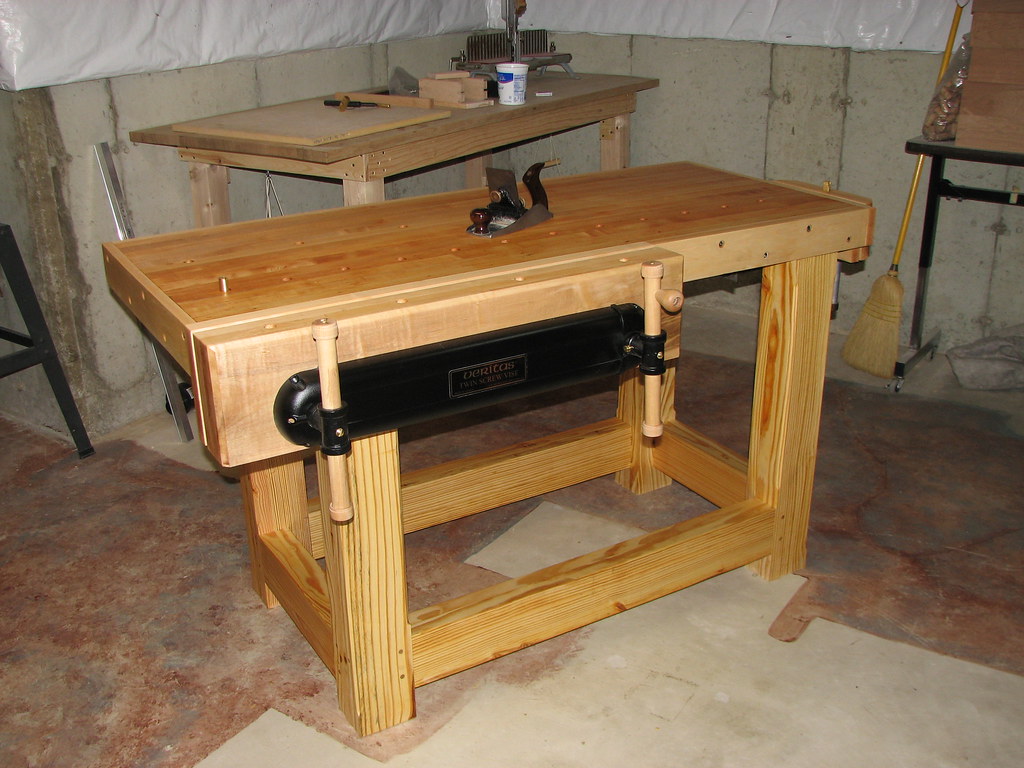So I'm a fairly new woodworking convert, having started about 2 years ago. I've spent very limited time on projects so I'd say it equals more like a few months experience. The whole time I've wanted a proper workbench for which I've been piecing hardware together over the last 2 years. The idea started out slow and vague but as I did more research I decided to somewhat follow Christopher Schwarz' Roubo design in the Workbench Design Book. It's obviously not super faithful with the double laminated top but it's close. I recently moved in with my girlfriend and my garage space shrunk which means not as many power tools available which finally kicked me in to gear to finish this stupid bench!
The Plan
Here's my sketchup design. It will be made using 100% kiln-dried Douglas Fir 8' studs because I can't afford good wood. It'll be 72" long, 24" deep and about 30-32" tall. Haven't finalized the height yet. The top will be just under 5" thick. The legs will be split down the middle for a 2 wide x 4 deep lamination on each. I was too lazy to add that in the plans. The rest is fairly standard: leg chop, end vise (aligned with the dog holes, another lazy bit on the sketch), sliding deadman and a shelf. I overbuilt this to make up for the lightness of Douglas Fir. Here we go...
The First Half
Over the course of 2 months I've been going to Home Depot or Lowe's and taking my dear sweet time picking out as tight grain, clear, straight boards as I could find. I'd spend an hour digging through the stacks to leave with sometimes 1 or 2 boards, sometimes 8-10. Worth my time? Probably not.
Here I'm starting to mill up the studs to be square. They are roughly 1.25" x 2.5" x 74" each, cut long to leave room for the final squaring of the completed top.
All square-ish! Turns out the jointer knives were a bit crooked and I never checked close enough. Now they all don't quite line up right with about a 1/16" lip made from the top of each board being a little crooked. Oops.
The glue-up! Not as horrible as I was anticipating at this stage, what with every board being out of square.
Cauls are somewhat useless here, which I only found out as I was gluing up.
Lots of work to get this flat...
Flat-ish! This will be the very top of the bench. This took way too long and I was exhausted afterwards. I learned I need to be sharpening my plane blade early and often, especially with all my excess glue. Hindsight is 20/20, right?
The Second Half
The second batch of boards squared up. I was able to fix the jointer knives over Christmas time so these are all dead square now. Oh, how much easier everything was.
Second slab all glued up. I maybe got a little excited with the glue. I didn't have a second set of hands for this one so I smothered it a bit to make up for lost time. Oops.
With the boards now straight and square I didn't have to hock off 3/32" from the whole thing like before. Pair that with a sharp blade and this was so much easier!
I told you I got a little overzealous with the glue...
Once both slabs were flattened on their mating faces it was time to combine them. I didn't get a picture but the original slab which had been sitting around for 2 weeks developed about a 3/32"-1/8" bow in it. I panicked a bit and started thinking about how to fix this before I jump to any conclusions. Thankfully DFir is so soft that my cauls were able to cinch down the gap plenty easy. I took my time to do a proper glue layer to maximize the strength on the faces. Let's just hope the glue holds!
That's it for now. I'll get more steps done this coming week hopefully. Can't wait for the actual difficult steps...
















 Reply With Quote
Reply With Quote











